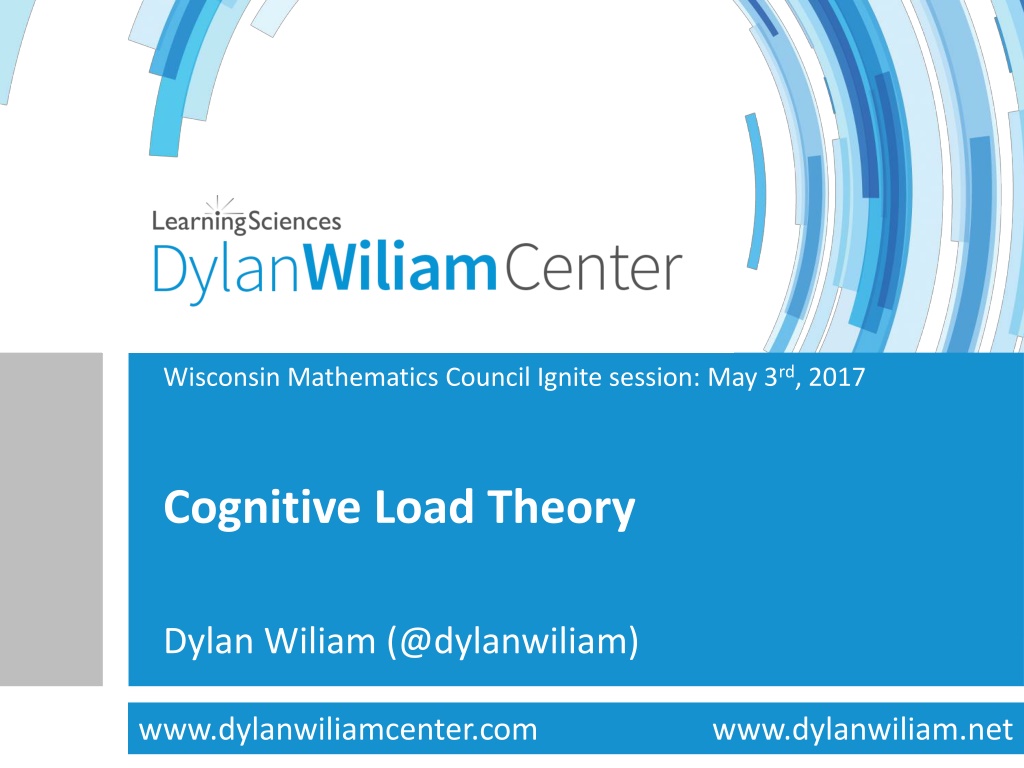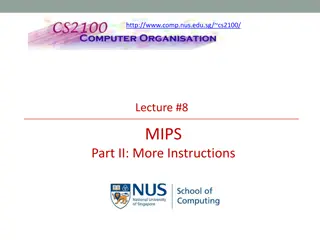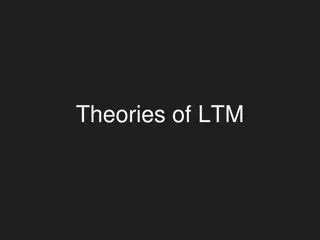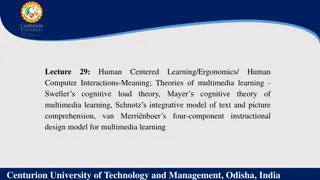Understanding Cognitive Load Theory and Memory in Learning
Explore the Wisconsin Mathematics Council Ignite session on Cognitive Load Theory and memory in learning by Dylan Wiliam. Discover the types of knowledge, human memory models, the purpose of math instruction, and the role of memory in chess. Learn about the significance of long-term memory in learning and how novices and experts approach thinking and knowledge. Delve into the intricate aspects of learning as a transformation in long-term memory.
Uploaded on Nov 12, 2024 | 0 Views
Download Presentation

Please find below an Image/Link to download the presentation.
The content on the website is provided AS IS for your information and personal use only. It may not be sold, licensed, or shared on other websites without obtaining consent from the author. Download presentation by click this link. If you encounter any issues during the download, it is possible that the publisher has removed the file from their server.
E N D
Presentation Transcript
Wisconsin Mathematics Council Ignite session: May 3rd, 2017 Cognitive Load Theory Dylan Wiliam (@dylanwiliam) www.dylanwiliamcenter.com www.dylanwiliam.net
Kinds of knowledge: an evolutionary approach 2 Biologically primary knowledge Recognizing faces Recognizing speech General problem solving Learnable Biologically secondary knowledge Reading Writing Mathematics Learnable Geary (2007, 2008)
Countdown game Target number: 127 3 25 1 9 4
A model of human memory 4 Short-term memory Long-term memory Environment Limited Limitless
5 The purpose of math instruction is to build domain- specific mathematical knowledge i.e., long-term memory
Memory in chess 6 Studies of memory in chess Djakow, Petrovskij, and Rudik (1927) Adriaan De Groot (1946) Chase and Simon (1973)
Memory in chess (1) 7 Player level Number of pieces correctly placed Mid-game Novice Club player Expert 5 9 16 Player level Number of pieces correctly placed Random Novice Club player Expert 2 3 3
Memory in chess (2) 8 Player level Number of pieces correctly placed End game Novice Club player Expert 4 7 8 Attempts to simulate the performance of the expert chess player with computers suggest that the expert can recognize at least 10,000, but less than 100,000, different arrangements of chess pieces or chunks, with a most likely value around 13,500 (Simon & Gilmartin, 1973)
What is learning? 9 Learning is a change in long-term memory (Kirschner, Sweller, & Clark, 2016 p. 77) The aim of all instruction is to alter long-term memory. If nothing has changed in long-term memory, nothing has been learned. (ibid p. 77) Novices need to use thinking skills. Experts use knowledge (Sweller et al., 2011 p. 21)
John Sweller 10
A mathematical problem 11 Transform a given number to a target number using just two mathematical operations: subtract 29 multiply by 3 For example Starting number: 27 Target number: 1027 Solution: x 3, 29, x 3, 29, x 3, 29, x 3, 29
The origins of cognitive load theory 12 All the problems could be solved only in one way, which involved alternating the two available operations Students solved the problems But they did not notice the fact that all the problems had similar solution strategies For novices, solving problems is not the best way to get better at solving problems
Cognitive load theory 13 Cognitive load Intrinsic imposed by the basic structure of information being taught Extraneous imposed by the manner in which the information is presented or the activities in which learners must engage Levels of cognitive load are determined by element interactivity
Element interactivity 14 Interacting elements are defined as elements that must be processed simultaneously in working memory because they are logically related (Sweller, Ayres, & Kalyuga, 2011 p. 58) Low Medium High Scalene Isosceles Equilateral
Instructional design 15 Good instruction minimizes both extraneous and intrinsic cognitive load Extraneous cognitive load is reduced through good instructional design Intrinsic cognitive load is reduced through good instructional sequencing
The goal-free effect 16 When novices solve a conventional problem, they will frequently work backwards from the goal to the givens using a means ends strategy. In contrast, experts, using schemas held in long- term memory, know the solution and are more likely to work forward from the givens to the goal. Working memory may be overwhelmed by a means ends strategy, reducing or even preventing learning
Worked-example/problem completion effects 17 Studying worked examples provides one of the best, possibly the best, means of learning how to solve problems in a novel domain. (p. 107) Strategies Present worked example and ask students to solve a similar problem Increase engagement by using completion problems Guidance fading: forwards is better than backwards
Split-attention effect 18 In the figure shown, find a value for DBE Solution: ABC DBE A = 180 BAC BCA = 180 45 55 = 80 = ABC (vertically opposite) = 80 45 B 55 D C Sweller, Merrienboer and Paas (1998) E
Integrated example with no split attention 19 A 45 1 180 55 45 = 80 B 55 D C 80 2 E
Other important aspects 20 Redundancy Modality effects Transient information effects Expertise reversal effect Collective working memory effects























